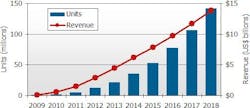Pocket-projector shipments to reach 142 million units by 2018, predicts DisplaySearch
Austin, TX--The market for pocket projectors -- small handheld devices that enable a large image to be projected onto a wall -- is poised for strong growth in 2010 and beyond. In its recently released Pocket Projector Technology and Market Forecast Report, DisplaySearch forecasts that the total pocket-projector market will grow from 0.5 million units and $117 million in revenues in 2009 to 142 million units and $13.9 billion in revenues in 2018, a compound annual growth rate (CAGR) of 70% for revenues and 88% for units (graph source: DisplaySearchPocket Projector Technology and Market Forecast Report).
"There were over 130 new pocket-projector models released in the market in 2009, along with the first releases of embedded projectors into the market," noted Jennifer Colgrove, director of display technologies at DisplaySearch. "Despite this, pocket projectors still face challenges of low brightness, short battery life and high price. Continuing progress in all the technologies surrounding pocket projectors will be needed to achieve the expected growth. Good things really do come in small packages, as pocket projectors eliminate form-factor and size limitations for images in portable electronics. They are ideal devices for sharing, either for social, business, or entertaining activities."
Additional findings
The pocket-projector market is currently dominated by standalone devices, which can be connected to other devices, and allow for additional integrated functions. DisplaySearch forecasts the standalone pocket projector will reach 45 million units and $8.9 billion in 2018.
However, DisplaySearch forecasts that shipments of embedded/dedicated projectors will surpass those of standalone units in 2014, as current limitations in power consumption, size, brightness, and price are improved. DisplaySearch forecasts the embedded-type pocket projectors will reach 97 million units and $5 billion in 2018.
Although pocket projectors using liquid-crystal on silicon (LCOS) with color filters dominated in 2009 due to early entrance of this technology in the pocket-projector market, DisplaySearch forecasts that digital-light-processing (DLP) and LCOS field-sequential technologies will take the lead in shipments for 2010. While LCOS field-sequential will have the highest unit share in coming years, DLP will lead in revenues. The fastest-growing technology in unit and revenue terms will be scanning MEMS (microelectromechanical systems).
The DisplaySearch report discusses the technology challenges for microdisplays, light sources, batteries, and the supply chain. It also provides pocket-projector specification analysis, BOM (bill of material) analysis, and business strategy recommendation and entrance opportunities. The report profiles about 200 pocket projector-related companies, providing market-history data in 2009 and a market forecast through 2018.
More information on the DisplaySearch report can be obtained by emailing [email protected].
Picoprojectors and lasers
The smallest type of device in the pocket-projector category is the picoprojector--small enough to be embedded in a small mobile phone. Red-green-blue (RGB) laser-projection technology looks promising for use in picoprojectors; tiny, reliable blue and red laser diodes are already commonplace, and reliable green laser diodes are under development.

John Wallace | Senior Technical Editor (1998-2022)
John Wallace was with Laser Focus World for nearly 25 years, retiring in late June 2022. He obtained a bachelor's degree in mechanical engineering and physics at Rutgers University and a master's in optical engineering at the University of Rochester. Before becoming an editor, John worked as an engineer at RCA, Exxon, Eastman Kodak, and GCA Corporation.
